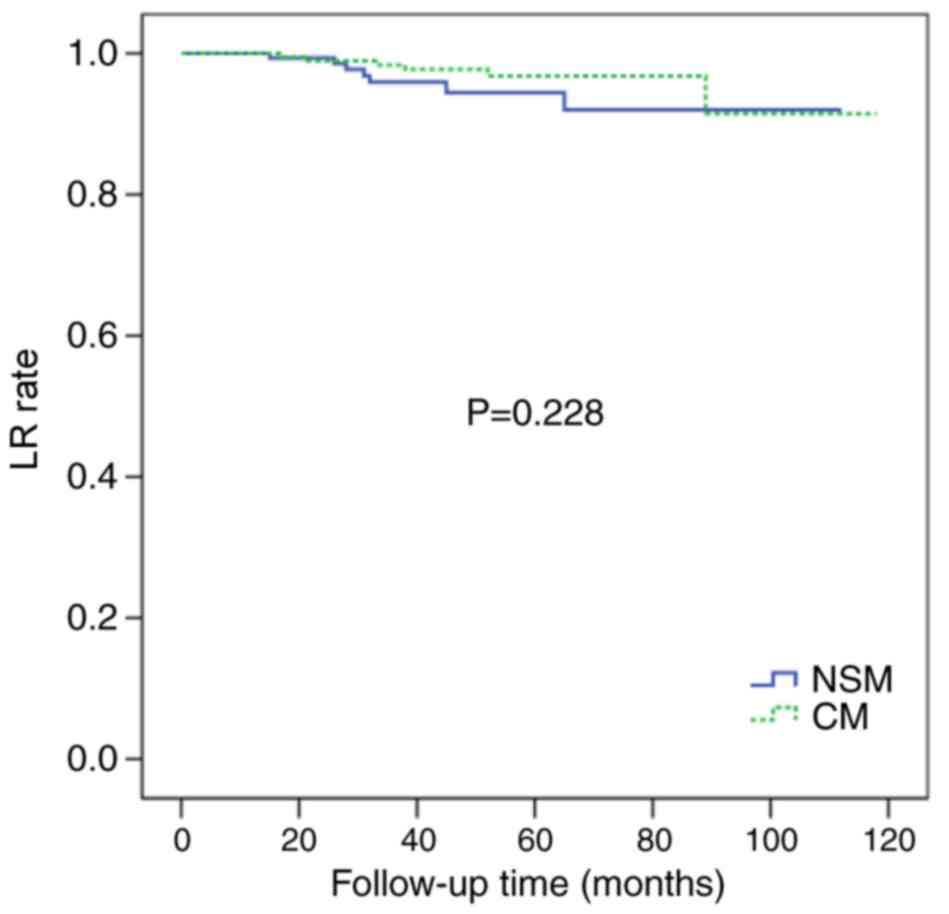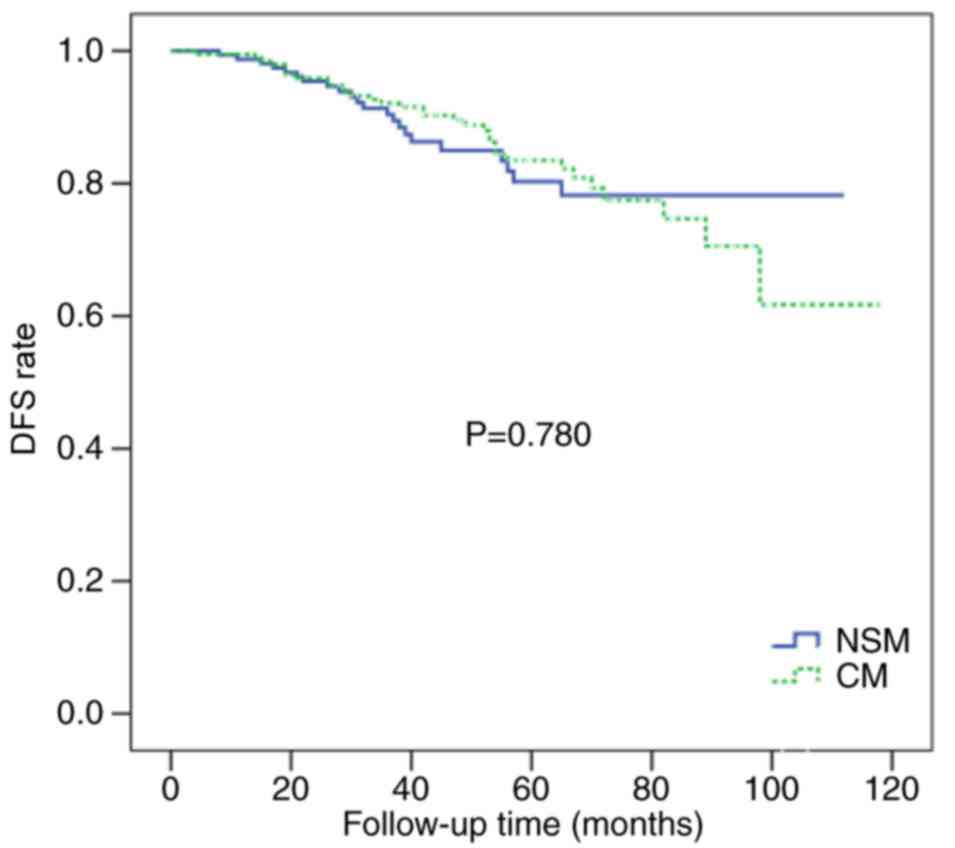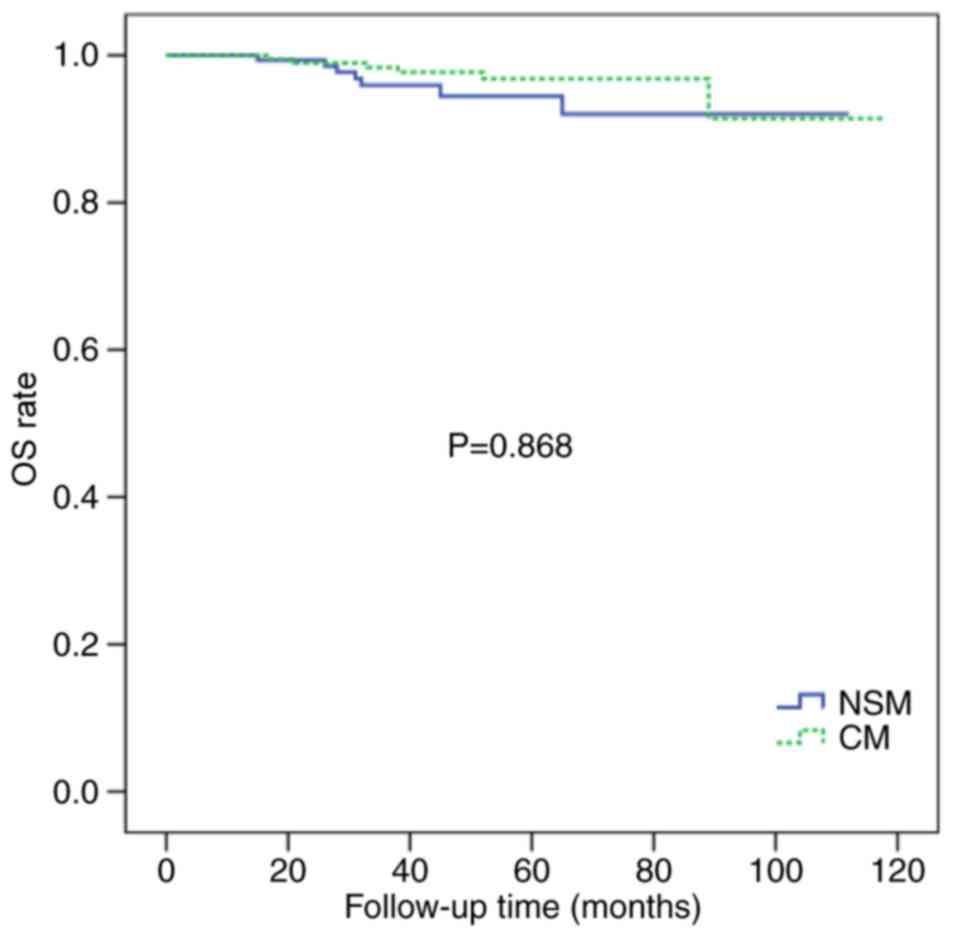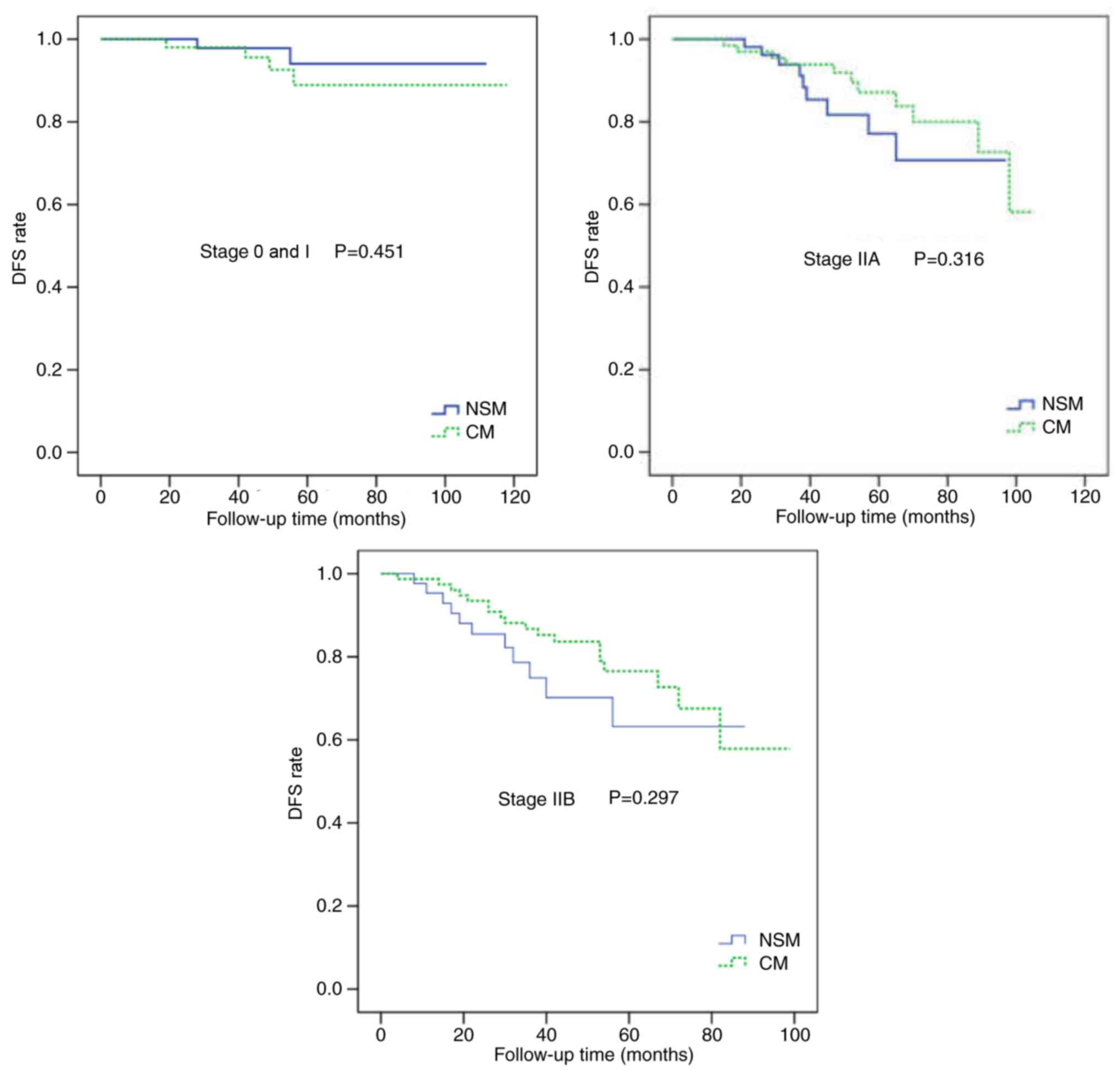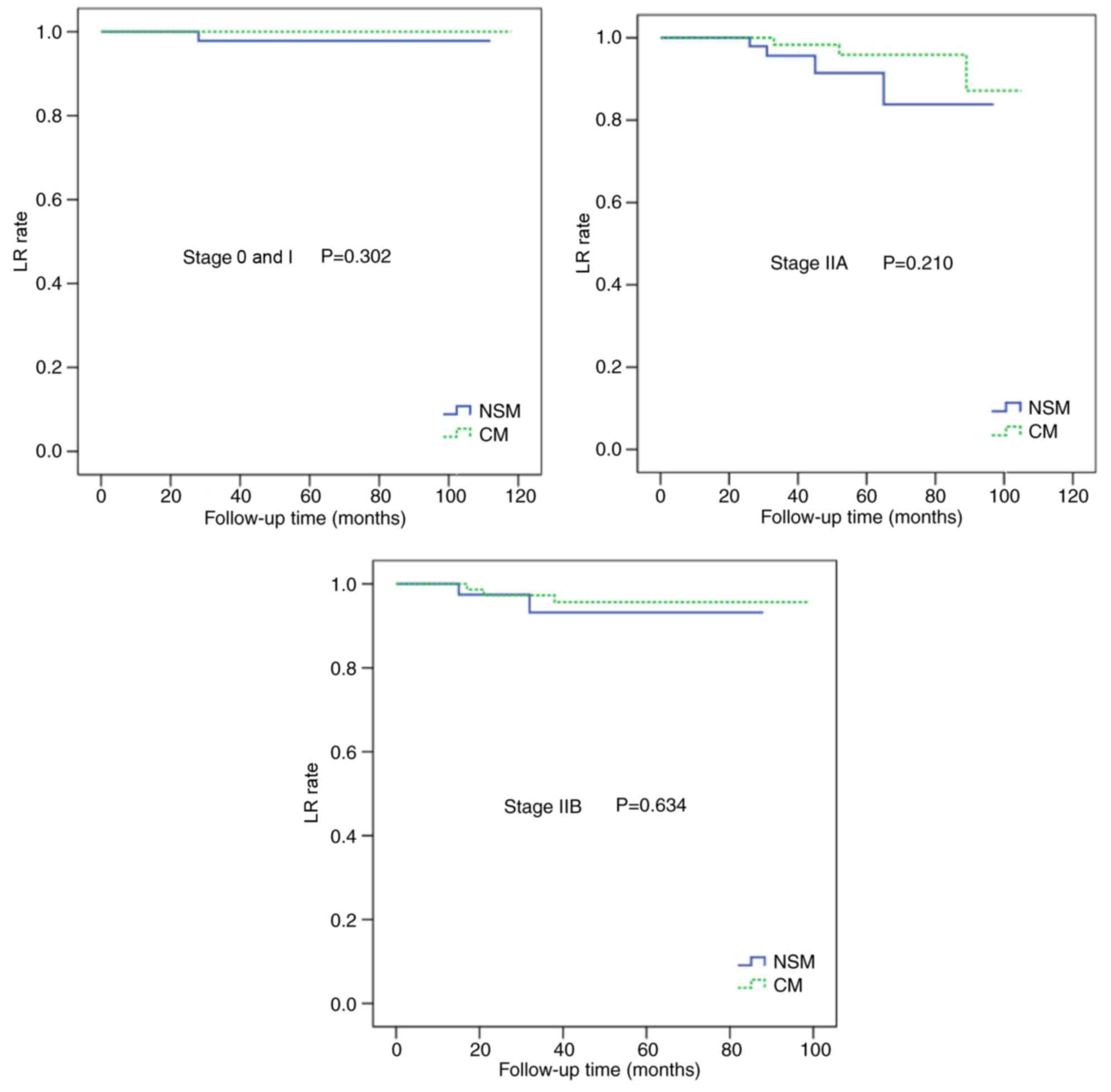|
1
|
Halsted WS: I. The results of radical
operations for the cure of carcinoma of the breast. Ann Surg.
46:1–19. 1907. View Article : Google Scholar : PubMed/NCBI
|
|
2
|
Madden JL: Modified radical mastectomy.
Surg Gynecol Obstet. 121:1221–1230. 1965.PubMed/NCBI
|
|
3
|
Clarke M, Collins R, Darby S, Davies C,
Elphinstone P, Evans V, Godwin J, Gray R, Hicks C, James S, et al:
Effects of radiotherapy and of differences in the extent of surgery
for early breast cancer on local recurrence and 15-year survival:
An overview of the randomised trials. Lancet. 366:2087–2106. 2005.
View Article : Google Scholar : PubMed/NCBI
|
|
4
|
Fisher B, Anderson S, Redmond CK, Wolmark
N, Wickerham DL and Cronin WM: Reanalysis and results after 12
years of follow-up in a randomized clinical trial comparing total
mastectomy with lumpectomy with or without irradiation in the
treatment of breast cancer. N Engl J Med. 333:1456–1461. 1995.
View Article : Google Scholar : PubMed/NCBI
|
|
5
|
Voogd AC, Nielsen M, Peterse JL,
Blichert-Toft M, Bartelink H, Overgaard M, van Tienhoven G,
Andersen KW, Sylvester RJ and van Dongen JA; Danish Breast Cancer
Cooperative Group, ; Breast Cancer Cooperative Group of the
European Organization for Research and Treatment of Cancer, :
Differences in risk factors for local and distant recurrence after
breast-conserving therapy or mastectomy for stage I and II breast
cancer: Pooled results of two large European randomized trials. J
Clin Oncol. 19:1688–1697. 2001. View Article : Google Scholar : PubMed/NCBI
|
|
6
|
Toth BA and Lappert P: Modified skin
incisions for mastectomy: The need for plastic surgical input in
preoperative planning. Plast Reconstr Surg. 87:1048–1053. 1991.
View Article : Google Scholar : PubMed/NCBI
|
|
7
|
Lanitis S, Tekkis PP, Sgourakis G,
Dimopoulos N, Al Mufti R and Hadjiminas DJ: Comparison of
skin-sparing mastectomy versus non-skin-sparing mastectomy for
breast cancer: A meta-analysis of observational studies. Ann Surg.
251:632–639. 2010. View Article : Google Scholar : PubMed/NCBI
|
|
8
|
Yi M, Kronowitz SJ, Meric-Bernstam F, Feig
BW, Symmans WF, Lucci A, Ross MI, Babiera GV, Kuerer HM and Hunt
KK: Local, regional, and systemic recurrence rates in patients
undergoing skin-sparing mastectomy compared with conventional
mastectomy. Cancer. 117:916–924. 2011. View Article : Google Scholar : PubMed/NCBI
|
|
9
|
Petit JY, Veronesi U, Orecchia R, Rey P,
Didier F, Giraldo A, Luini A, De Lorenzi F, Rietjens M, Garusi C,
et al: The nipple-sparing mastectomy: Early results of a
feasibility study of a new application of perioperative
radiotherapy (ELIOT) in the treatment of breast cancer when
mastectomy is indicated. Tumori. 89:288–291. 2003.PubMed/NCBI
|
|
10
|
Hinton CP, Doyle PJ, Blamey RW, Davies CJ,
Holliday HW and Elston CW: Subcutaneous mastectomy for primary
operable breast cancer. Br J Surg. 71:469–472. 1984. View Article : Google Scholar : PubMed/NCBI
|
|
11
|
Cense HA, Rutgers EJ, Lopes Cardozo M and
Van Lanschot JJ: Nipple-sparing mastectomy in breast cancer: A
viable option? Eur J Surg Oncol. 27:1–526. 2001. View Article : Google Scholar
|
|
12
|
Simmons RM, Brennan M, Christos P, King V
and Osborne M: Analysis of nipple/areolar involvement with
mastectomy: Can the areola be preserved? Ann Surg Oncol. 9:165–168.
2002. View Article : Google Scholar : PubMed/NCBI
|
|
13
|
Laronga C, Kemp B, Johnston D, Robb GL and
Singletary SE: The incidence of occult nipple-areola complex
involvement in breast cancer patients receiving a skin-sparing
mastectomy. Ann Surg Oncol. 6:609–613. 1999. View Article : Google Scholar : PubMed/NCBI
|
|
14
|
Brachtel EF, Rusby JE, Michaelson JS, Chen
LL, Muzikansky A, Smith BL and Koerner FC: Occult nipple
involvement in breast cancer: Clinicopathologic findings in 316
consecutive mastectomy specimens. J Clin Oncol. 27:4948–4954. 2009.
View Article : Google Scholar : PubMed/NCBI
|
|
15
|
Gerber B, Krause A, Dieterich M, Kundt G
and Reimer T: The oncological safety of skin sparing mastectomy
with conservation of the nipple-areola complex and autologous
reconstruction: An extended follow-up study. Ann Surg. 249:461–468.
2009. View Article : Google Scholar : PubMed/NCBI
|
|
16
|
Adam H, Bygdeson M and de Boniface J: The
oncological safety of nipple-sparing mastectomy-a Swedish matched
cohort study. Eur J Surg Oncol. 40:1209–1215. 2014. View Article : Google Scholar : PubMed/NCBI
|
|
17
|
Ou KW, Yu JC, Ho MH, Chiu WK, Ou KL, Chen
TM and Chen SG: Oncological safety and outcomes of nipple-sparing
mastectomy with breast reconstruction: A single-centered experience
in Taiwan. Ann Plast Surg. 74 Suppl 2:S127–S131. 2015. View Article : Google Scholar : PubMed/NCBI
|
|
18
|
Seki T, Jinno H, Okabayashi K, Murata T,
Matsumoto A, Takahashi M, Hayashida T and Kitagawa Y: Comparison of
oncological safety between nipple sparing mastectomy and total
mastectomy using propensity score matching. Ann R Coll Surg Engl.
97:291–297. 2015. View Article : Google Scholar : PubMed/NCBI
|
|
19
|
Headon HL, Kasem A and Mokbel K: The
oncological safety of Nipple-sparing mastectomy: A systematic
review of the literature with a pooled analysis of 12,358
procedures. Arch Plast Surg. 43:328–338. 2016. View Article : Google Scholar : PubMed/NCBI
|
|
20
|
Chung WB, Yi JE, Jin JY, Choi YS, Park CS,
Park WC, Song BJ and Youn HJ: Early cardiac function monitoring for
detection of subclinical Doxorubicin cardiotoxicity in young adult
patients with breast cancer. J Breast Cancer. 16:178–183. 2013.
View Article : Google Scholar : PubMed/NCBI
|
|
21
|
Anders CK, Hsu DS, Broadwater G, Acharya
CR, Foekens JA, Zhang Y, Wang Y, Marcom PK, Marks JR, Febbo PG, et
al: Young age at diagnosis correlates with worse prognosis and
defines a subset of breast cancers with shared patterns of gene
expression. J Clin Oncol. 26:3324–3330. 2008. View Article : Google Scholar : PubMed/NCBI
|
|
22
|
Fredholm H, Magnusson K, Lindstrom LS,
Garmo H, Fält SE, Lindman H, Bergh J, Holmberg L, Pontén F, Frisell
J and Fredriksson I: Long-term outcome in young women with breast
cancer: A population-based study. Breast Cancer Res Treat.
160:131–143. 2016. View Article : Google Scholar : PubMed/NCBI
|
|
23
|
Bharat A, Aft RL, Gao F and Margenthaler
JA: Patient and tumor characteristics associated with increased
mortality in young women (< or =40 years) with breast cancer. J
Surg Oncol. 100:248–251. 2009. View Article : Google Scholar : PubMed/NCBI
|
|
24
|
Fredholm H, Eaker S, Frisell J, Holmberg
L, Fredriksson I and Lindman H: Breast cancer in young women: Poor
survival despite intensive treatment. PLoS One. 4:e76952009.
View Article : Google Scholar : PubMed/NCBI
|
|
25
|
Gnerlich JL, Deshpande AD, Jeffe DB, Sweet
A, White N and Margenthaler JA: Elevated breast cancer mortality in
women younger than age 40 years compared with older women is
attributed to poorer survival in early-stage disease. J Am Coll
Surg. 208:341–347. 2009. View Article : Google Scholar : PubMed/NCBI
|
|
26
|
Kroman N, Holtveg H, Wohlfahrt J, Jensen
MB, Mouridsen HT, Blichert-Toft M and Melbye M: Effect of
breast-conserving therapy versus radical mastectomy on prognosis
for young women with breast carcinoma. Cancer. 100:688–693. 2004.
View Article : Google Scholar : PubMed/NCBI
|
|
27
|
Bantema-Joppe EJ, de Munck L, Visser O,
Willemse PH, Langendijk JA, Siesling S and Maduro JH: Early-stage
young breast cancer patients: Impact of local treatment on
survival. Int J Radiat Oncol Biol Phys. 81:e553–e559. 2011.
View Article : Google Scholar : PubMed/NCBI
|
|
28
|
Amin MB, Edge SB, Greene FL, et al:
American Joint committee on cancer (AJCC)AJCC cancer staging
manual. 8th. New York: Springer; 2017, View Article : Google Scholar
|
|
29
|
National Comprehensive Cancer Network
(NCCN), . Clinical practice guidelines in oncology. Breast cancer,
version, 2007–2016. https://www.nccn.org/professionals/physician_gls/default.aspx#breast
|
|
30
|
Rits IA: Declaration of helsinki.
Recommendations guidings doctors in clinical research. World Med J.
11:2811964.PubMed/NCBI
|
|
31
|
Kinoshita S, Nojima K, Takeishi M, Imawari
Y, Kyoda S, Hirano A, Akiba T, Kobayashi S, Takeyama H, Uchida K
and Morikawa T: Retrospective comparison of non-skin-sparing
mastectomy and skin-sparing mastectomy with immediate breast
reconstruction. Int J Surg Oncol. 2011:8765202011.PubMed/NCBI
|
|
32
|
Burdge EC, Yuen J, Hardee M, Gadgil PV,
Das C, Henry-Tillman R, Ochoa D, Korourian S and Suzanne Klimberg
V: Nipple skin-sparing mastectomy is feasible for advanced disease.
Ann Surg Oncol. 20:3294–3302. 2013. View Article : Google Scholar : PubMed/NCBI
|
|
33
|
Benediktsson KP and Perbeck L: Survival in
breast cancer after nipple-sparing subcutaneous mastectomy and
immediate reconstruction with implants: A prospective trial with 13
years median follow-up in 216 patients. Eur J Surg Oncol.
34:143–148. 2008. View Article : Google Scholar : PubMed/NCBI
|
|
34
|
Shimo A, Tsugawa K, Tsuchiya S, Yoshie R,
Tsuchiya K, Uejima T, Kojima Y, Shimo A, Hayami R, Nishikawa T, et
al: Oncologic outcomes and technical considerations of
nipple-sparing mastectomies in breast cancer: Experience of 425
cases from a single institution. Breast Cancer. 23:851–860. 2016.
View Article : Google Scholar : PubMed/NCBI
|
|
35
|
Orzalesi L, Casella D, Santi C, Cecconi L,
Murgo R, Rinaldi S, Regolo L, Amanti C, Roncella M, Serra M, et al:
Nipple sparing mastectomy: Surgical and oncological outcomes from a
national multicentric registry with 913 patients (1006 cases) over
a six year period. Breast. 25:75–81. 2016. View Article : Google Scholar : PubMed/NCBI
|
|
36
|
Morrison DH, Rahardja D, King E, Peng Y
and Sarode VR: Tumour biomarker expression relative to age and
molecular subtypes of invasive breast cancer. Br J Cancer.
107:382–387. 2012. View Article : Google Scholar : PubMed/NCBI
|
|
37
|
Tang LC, Jin X, Yang HY, He M, Chang H,
Shao ZM and Di GH: Luminal B subtype: A key factor for the worse
prognosis of young breast cancer patients in China. BMC Cancer.
15:2012015. View Article : Google Scholar : PubMed/NCBI
|
|
38
|
Lund MJ, Butler EN, Hair BY, Ward KC,
Andrews JH, Oprea-Ilies G, Bayakly AR, O'Regan RM, Vertino PM and
Eley JW: Age/race differences in HER2 testing and in incidence
rates for breast cancer triple subtypes: A population-based study
and first report. Cancer. 116:2549–2559. 2010.PubMed/NCBI
|
|
39
|
Colleoni M, Rotmensz N, Robertson C,
Orlando L, Viale G, Renne G, Luini A, Veronesi P, Intra M, Orecchia
R, et al: Very young women (<35 years) with operable breast
cancer: Features of disease at presentation. Ann Oncol. 13:273–279.
2002. View Article : Google Scholar : PubMed/NCBI
|
|
40
|
Petit JY, Veronesi U, Orecchia R,
Curigliano G, Rey PC, Botteri E, Rotmensz N, Lohsiriwat V, Cassilha
Kneubil M and Rietjens M: Risk factors associated with recurrence
after nipple-sparing mastectomy for invasive and intraepithelial
neoplasia. Ann Oncol. 23:2053–2058. 2012. View Article : Google Scholar : PubMed/NCBI
|
|
41
|
Donovan CA, Harit AP, Chung A, Bao J,
Giuliano AE and Amersi F: Oncological and surgical outcomes after
Nipple-sparing mastectomy: Do incisions matter? Ann Surg Oncol.
23:3226–3231. 2016. View Article : Google Scholar : PubMed/NCBI
|
|
42
|
Laporta R, Longo B, Sorotos M, Farcomeni
A, Patti C, Mastrangeli MR, Rubino C and Santanelli di Pompeo F:
Breast reconstruction following nipple-sparing mastectomy: Clinical
outcomes and risk factors related complications. J Plast Surg Hand
Surg. 51:427–435. 2017. View Article : Google Scholar : PubMed/NCBI
|
|
43
|
Salgarello M, Visconti G and Barone-Adesi
L: Nipple-sparing mastectomy with immediate implant reconstruction:
Cosmetic outcomes and technical refinements. Plast Reconstr Surg.
126:1460–1471. 2010. View Article : Google Scholar : PubMed/NCBI
|
|
44
|
Yueh JH, Houlihan MJ, Slavin SA, Lee BT,
Pories SE and Morris DJ: Nipple-sparing mastectomy: Evaluation of
patient satisfaction, aesthetic results, and sensation. Ann Plast
Surg. 62:586–590. 2009. View Article : Google Scholar : PubMed/NCBI
|
|
45
|
Fobair P, Stewart SL, Chang S, D'Onofrio
C, Banks PJ and Bloom JR: Body image and sexual problems in young
women with breast cancer. Psycho Oncol. 15:579–594. 2006.
View Article : Google Scholar
|















